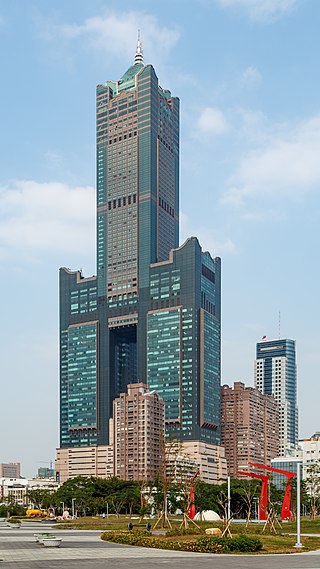
Taipei 101, formerly known as the Taipei World Financial Center, is a skyscraper in Taipei, Taiwan. It is owned by Taipei Financial Center Corporation. The building was officially classified as the world's tallest from its opening on 31 December 2004. However, the Burj Khalifa surpassed Taipei 101 in 2009. Upon completion, it became the world's first skyscraper to exceed a height of half a kilometer. As of 2023, Taipei 101 is the tallest building in Taiwan and the eleventh tallest building in the world.

85 Sky Tower, formerly known as the T & C Tower or Tuntex Sky Tower, is an 85-story skyscraper in Lingya District, Kaohsiung, Taiwan. The structure is 347.5 m (1,140 ft) high. An antenna increases the pinnacle height to 378 m (1,240 ft). Constructed from 1994 to 1997 by the now-defunct Tuntex Group, it is the tallest building in Kaohsiung, and the 2nd tallest in Taiwan after the Taipei 101.

Chu-yuanLee is a Taiwanese architect born in Guangdong, Republic of China. He received his bachelor's degree from National Cheng Kung University (Tainan) and his master's from Princeton University in the US. He directed the design of Taipei 101, the world's tallest skyscraper at the time of completion, in 2004.

The Chang-Gu World Trade Center, also known as Grand 50 Tower, is a 222 metres (728 ft) tall skyscraper in Sanmin District of Kaohsiung, Taiwan. It was completed in 1992 and was designed by C.Y. Lee & Partners. It was the first building in Taiwan to reach a height of 50 floors, as is highlighted by its alternative name.

Shin Kong Life Tower, at 51 stories and a height of 245 meters (803.8 ft), is one of Taiwan's earliest skyscrapers. The rose-colored tower topped by a pyramid stands in Zhongzheng District, Taipei, and dates from 1993. Its first twelve floors and two underground floors house a Shin Kong Mitsukoshi Department Store; the remaining floors provide office space and serve as headquarters for the Shin Kong Life insurance company. The building stands across Zhongxiao Road from Taipei Main Station near the Asiaworld Department Store.

The Pangu Plaza (Chinese: 盘古大观) is a five mixed used buildings complex comprises an office building, three apartment buildings, clubs, retail and Pangu 7 Star Hotel (Pangu Seven Star Hotel) which located at 27, North 4th Ring Middle Road, Chaoyang, Beijing, China. Shaped like a dragon, it is neighbor with many of the 2008 Beijing Olympic venues, including the Beijing National Stadium (Bird Nest) and the Beijing National Aquatics Center (Water Cube). Also, it is close to the National Library, the fourth largest library in the world and the largest one in China. The Pangu Plaza was designed by Chu-Yuan Lee of C.Y. Lee & Partners, the Taiwan-based architecture firm responsible for Taipei 101, for the world's first traditional Chinese “courtyard in the sky." Pangu 7 Star Hotel occupies the "First Block" of the "Pangu", and it contains two pavilions, a temple, a French restaurant, a Top Class Japanese restaurant, 234 guest rooms, with 140 suites, and a 600-metre-long (2,000 ft) corridor. Pangu Plaza is a building invested and built by Guo Wengui in 2008.
The Taipei Twin Towers is a supertall skyscraper development in Taipei, Taiwan. Scheduled to be completed in 2027, it will include two skyscrapers, the taller of which is 369 metres with 74 floors and the shorter of which is 289 metres with 55 floors. It is located near Taipei Station, Shin Kong Life Tower, and Taipei Bus Station. When the complex is complete, the taller tower will be the second tallest building in Taiwan, surpassing the 347.5 metres 85 Sky Tower in Kaohsiung, which was completed in 1997. It is estimated to cost NT$60.6 billion.

Chung Tai Chan Monastery is a Buddhist monastery located in Puli Township, Nantou County, Taiwan. It is the headquarters of Chung Tai Shan, an international Chan Buddhist order. It is the tallest and one of the largest monasteries in both Taiwan and the world, having a height of 136 metres (446 ft). Widely admired as an architectural masterpiece because of the mountain monastery's more modern look, the temple is second only to Fo Guang Shan's monastery in physical size and in the number of ordained disciples.
The architecture of Taiwan can be traced back to stilt housing of the aborigines in prehistoric times; to the building of fortresses and churches in the north and south used to colonize and convert the inhabitants during the Dutch and Spanish period; the Tungning period when Taiwan was a base of anti-Qing sentiment and Minnan-style architecture was introduced; in Qing dynasty period, a mix of Chinese and Western architecture appeared and artillery battery flourished during Qing's Self-Strengthening Movement; During the Japanese rule of Taiwan, the Minnan, Japanese and Western culture were main influencers in architectural designs and saw the introduction and use of reinforced concrete. Due to excessive Westernization as a colony, after the retrocession of Taiwan to the Republic of China in 1945 from Japan at the end of World War II, Chinese classical style became popular and entered into international mainstream as a postmodern design style. Today, Taiwanese architecture has undergone much diversification, every style of architecture can be seen.

Taipei Nan Shan Plaza is a skyscraper in Xinyi Special District, Xinyi, Taipei, Taiwan. It is the second tallest building in Taipei and the third tallest building in Taiwan. As of 2019, it is the 146th-tallest building in Asia and 248th-tallest building in the world.

The Asia-Pacific Financial Plaza is a 169.8 metres (557 ft) tall skyscraper in Lingya District of Kaohsiung, Taiwan. It was completed in 1992 and was designed by Hoy Architects & Associates. It was the first building in Taiwan to reach a height of 150 m.

The Crystal Plaza, also known as Water Cube, is a residential skyscraper located in Tamsui, New Taipei, Taiwan. It is designed by C.Y. Lee & Partners and was completed in 2013. The height of the building is 160.6 m (527 ft), with a floor area of 60,278.65 m2 (648,834.0 sq ft), and it has 41 floors above ground, as well as six basement levels. It is the tallest building in Tamsui.
The Asia Plaza is a vision supertall skyscraper that will rise 431 m (1,414 ft) in Kaohsiung, Taiwan. The building will comprise 103 floors above ground as well as 7 basement levels. It is a part of the Asia Plaza Tri-Tower Complex, that comprise three buildings: the 103-storey Asia Plaza, the 49-storey Far Eastern Ding Ding Hotel and the 18-storey Mega'21 Far Eastern Shopping Complex, of which only the shopping complex was completed in 2001.

The Blue Ocean is a residential skyscraper located in Tamsui District, New Taipei, Taiwan. Construction began in 2007 and it was completed in 2010. Designed by the Taiwanese architect C.Y. Lee & Partners, the height of the building is 150 m (490 ft), and it comprises 38 floors above ground, as well as three basement levels. It was the tallest building in Tamsui when completed until it was surpassed by The Crystal Plaza in 2013. The building offers 180 apartment units, with facilities including a banquet hall, two swimming pools and a fitness center for the residents.

The Asia Plaza Building is a 27-story, 101 m (331 ft) skyscraper office building located in Zhongzheng District, Taipei, Taiwan. The building was designed by Taiwanese architect Chu-Yuan Lee. When the building was completed in 1990, it was the tallest in West Taipei, but was surpassed by Shin Kong Life Tower in 1993. The higher floors of the building house offices, hotels, a gym and a cram school, whilst the lower floors of the building house a department store.












